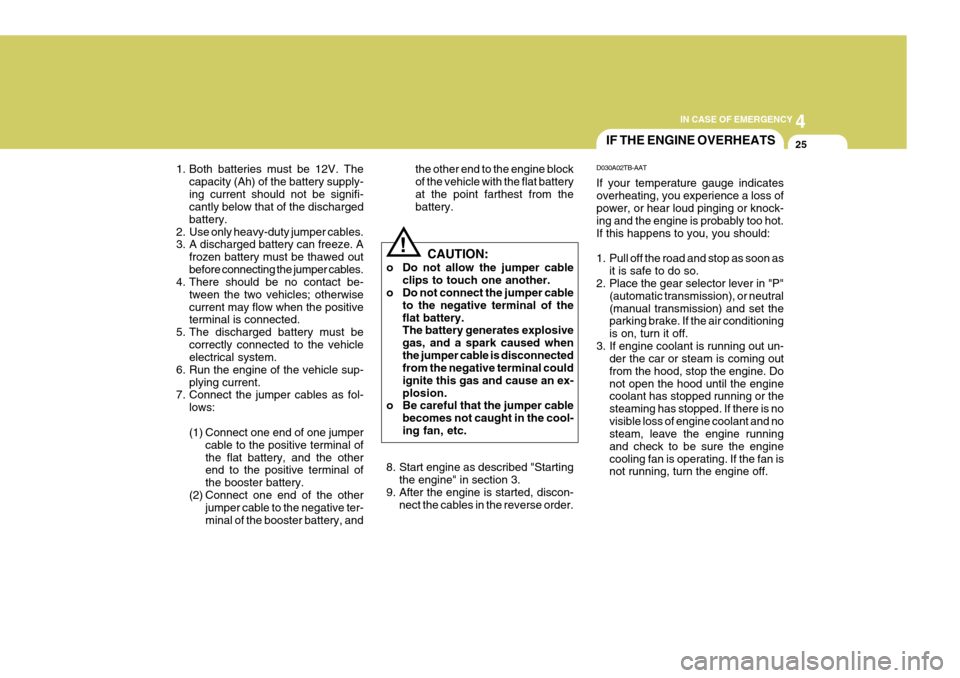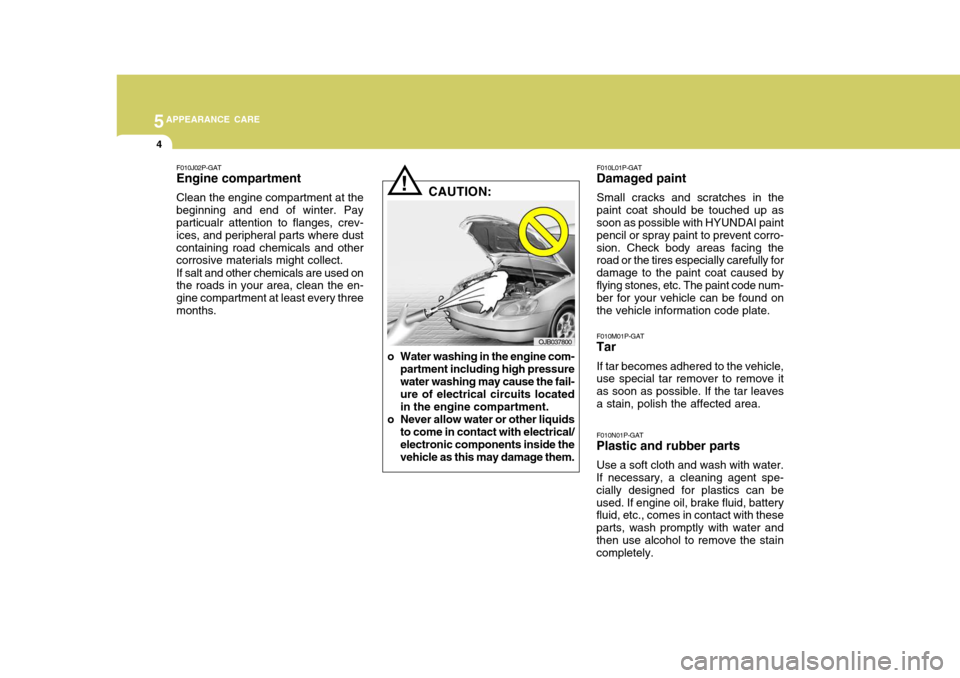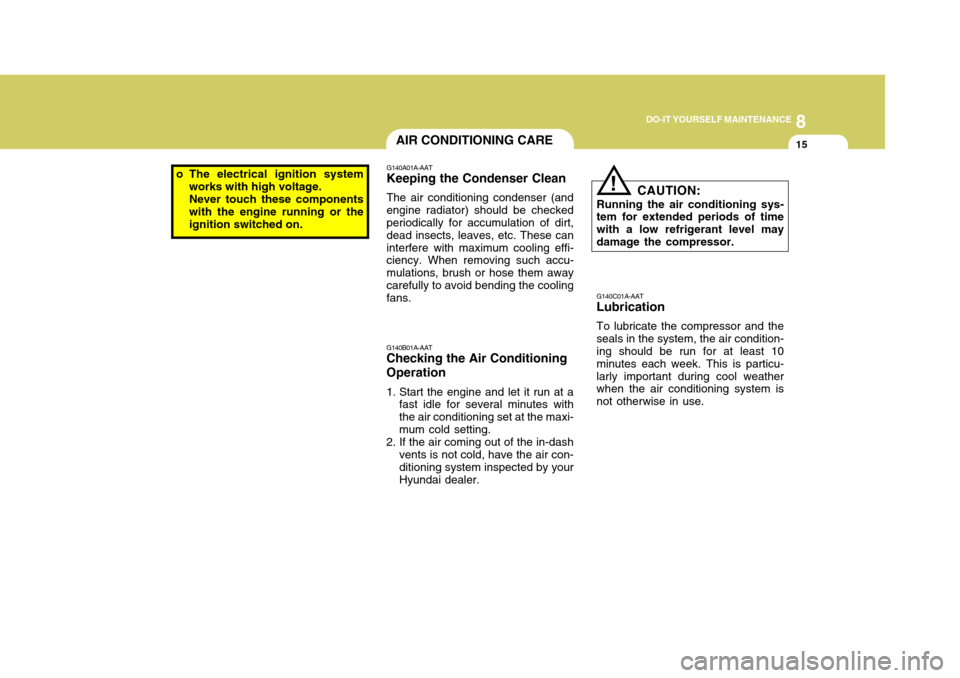2007 Hyundai H-1 (Grand Starex) Electrical
[x] Cancel search: ElectricalPage 196 of 284

44IN CASE OF EMERGENCY
20
!WARNING:
o Improperly loading your car and trailer can serious affect its steer- ing and braking performance causing a crash in which youmay be seriously injured.
o For automatic transmission ve-
hicles, the trailer should be towedwith the towing vehicle unloaded, with the exception of the driver. Otherwise, the automatic trans-mission oil temperature may rise to a temperature that may result in serious damage of the auto- matic transmission. C190F02A-GAT Trailer or Vehicle Towing Tips
1. Before towing, check hitch and
safety chain connections as well as proper operation of the trailer run- ning lights, brake lights, and turn signals.
2. Always drive your vehicle at a mod- erate speed (Less than 100 km/h).
3. Trailer towing requires more fuel than normal conditions.
4. To maintain engine braking effi-
ciency and electrical charging per-formance, do not use fifth gear (manual transmission) or overdrive (automatic transmission).
5. Always secure items in the trailer to prevent load shift while driving.
6. Check the condition and air pres- sure of all tires on the trailer and your car. Low tire pressure can se- riously affect the handling. Alsocheck the spare tire.
7. The vehicle/trailer combination is
more affected by crosswind andbuffeting. When being passed by a large vehicle, keep a constant speed and steer straight ahead. If there is too much wind buffeting,slow down to get out of the othervehicle’s air turbulence.
8. When parking your car and trailer,
especially on a hill, be sure to followall the normal precautions. Turn your front wheel into the curb, set the parking brake firmly, and put thetransmission in 1st or "R" (manual transmission) or "P" (automatic transmission). In addition, placewheel chocks at each of the trailer’s tires.
9. If the trailer has electric brakes, start your vehicle and trailer mov-ing, and then apply the trailer brake controller by hand to be sure thebrakes are working. This lets you check your electrical connection at the same time.
10.During your trip, check occasion- ally to be sure that the load issecure, and that the lights and anytrailer brakes are still working.
11.Avoid jerky starts, sudden accel-
eration or sudden stops.
12.Avoid sharp turns and rapid lane changes.
Page 201 of 284

4
CORROSION PREVENTION AND APPEARANCE CARE
25
4
IN CASE OF EMERGENCY
25IF THE ENGINE OVERHEATS
CAUTION:
o Do not allow the jumper cable clips to touch one another.
o Do not connect the jumper cable
to the negative terminal of the flat battery. The battery generates explosive gas, and a spark caused whenthe jumper cable is disconnected from the negative terminal could ignite this gas and cause an ex-plosion.
o Be careful that the jumper cable
becomes not caught in the cool-ing fan, etc.
! D030A02TB-AAT If your temperature gauge indicates overheating, you experience a loss of power, or hear loud pinging or knock- ing and the engine is probably too hot.If this happens to you, you should:
1. Pull off the road and stop as soon as
it is safe to do so.
2. Place the gear selector lever in "P"
(automatic transmission), or neutral (manual transmission) and set the parking brake. If the air conditioning is on, turn it off.
3. If engine coolant is running out un- der the car or steam is coming outfrom the hood, stop the engine. Donot open the hood until the engine coolant has stopped running or the steaming has stopped. If there is novisible loss of engine coolant and no steam, leave the engine running and check to be sure the enginecooling fan is operating. If the fan is not running, turn the engine off.
the other end to the engine block of the vehicle with the flat batteryat the point farthest from the battery.
8. Start engine as described "Starting the engine" in section 3.
9. After the engine is started, discon- nect the cables in the reverse order.
1. Both batteries must be 12V. The
capacity (Ah) of the battery supply- ing current should not be signifi- cantly below that of the discharged battery.
2. Use only heavy-duty jumper cables.
3. A discharged battery can freeze. A
frozen battery must be thawed out before connecting the jumper cables.
4. There should be no contact be-
tween the two vehicles; otherwisecurrent may flow when the positive terminal is connected.
5. The discharged battery must be correctly connected to the vehicleelectrical system.
6. Run the engine of the vehicle sup- plying current.
7. Connect the jumper cables as fol-
lows:
(1) Connect one end of one jumper cable to the positive terminal of the flat battery, and the other end to the positive terminal of the booster battery.
(2) Connect one end of the other jumper cable to the negative ter-minal of the booster battery, and
Page 203 of 284

4
CORROSION PREVENTION AND APPEARANCE CARE
27
4
IN CASE OF EMERGENCY
27
CAUTION:
When replacing a fusible link, never use anything but a new fusible link with the same or lower amperagerating. Never use a piece of wire or a higher-rated fusible link. This could result in serious damage andcreate a fire hazard.! G200B02A-AAT Replacing Accessory Fuse The fuse box for the lights and other electrical accessories will be found lowon the dashboard on the driver's side. Inside the box you will find a list show- ing the circuits protected by each fuse.If any of your car's lights or other electrical accessories stop working, a blown fuse could be the reason. If thefuse has burned out, you will see that the metal strip inside the fuse has burned through.HSR4021
CHECKING AND REPLACING FUSES
G200A01A-AAT Replacing a Fusible Link
HSRFL200
Melted
Good
A fusible link will melt if the electrical circuits from the battery are ever over-loaded, thus preventing damage to the entire wiring harness. (This could be caused by a short in the system draw-ing too much current.) If this ever happens, have a Hyundai dealer de- termine the cause, repair the systemand replace the fusible link. The fusible links are located in a fuse box for easy inspection.
Page 204 of 284

44IN CASE OF EMERGENCY
28
If you suspect a blown fuse, follow this procedure:
1. Turn off the ignition and all other
switches.
2. Open the fuse box and examine each fuse. Remove each fuse by pulling it toward you (a small "fusepuller" tool is contained in the fuse box to simplify this operation).
3. Be sure to check all other fuses even if you find one that appears tohave burned out.
HSR40224. Replace the blown fuse by pressing
a new fuse of the same rating into place. The fuse should be a snug fit. If it is not, have the fuse clip repaired or replaced by a Hyundai dealer. Ifyou do not have a spare fuse, you may be able to borrow a fuse of the same or lower rating from an acces-sory you can temporarily get along without (the radio or cigarette light- er, for example). Always rememberto replace the borrowed fuse.
G200B02A
Good
Burned out
!
CAUTION:
A burned-out fuse indicates that there is a problem in the electrical circuit. If you replace a fuse and it blows as soon as the accessory isturned on, the problem is serious and should be referred to a Hyun- dai dealer for diagnosis and repair.Never replace a fuse with anything except a fuse with the same or a lower amperage rating. A highercapacity fuse could cause damage and create a fire hazard. NOTE: See page 4-40 for the fuse panel descriptions.
Page 225 of 284

5APPEARANCE CARE
4
F010L01P-GAT
Damaged paint
Small cracks and scratches in the
paint coat should be touched up as soon as possible with HYUNDAI paint pencil or spray paint to prevent corro-sion. Check body areas facing the road or the tires especially carefully for damage to the paint coat caused byflying stones, etc. The paint code num- ber for your vehicle can be found on the vehicle information code plate. F010M01P-GAT
Tar
If tar becomes adhered to the vehicle, use special tar remover to remove it as soon as possible. If the tar leavesa stain, polish the affected area. F010N01P-GAT
Plastic and rubber parts
Use a soft cloth and wash with water.
If necessary, a cleaning agent spe- cially designed for plastics can beused. If engine oil, brake fluid, battery fluid, etc., comes in contact with these parts, wash promptly with water andthen use alcohol to remove the stain completely.
! CAUTION:
o Water washing in the engine com- partment including high pressure water washing may cause the fail- ure of electrical circuits located in the engine compartment.
o Never allow water or other liquids to come in contact with electrical/electronic components inside thevehicle as this may damage them.
OJB037800
F010J02P-GAT Engine compartment Clean the engine compartment at the beginning and end of winter. Pay particualr attention to flanges, crev- ices, and peripheral parts where dustcontaining road chemicals and other corrosive materials might collect. If salt and other chemicals are used on the roads in your area, clean the en- gine compartment at least every threemonths.
Page 257 of 284

8
DO-IT YOURSELF MAINTENANCE
13
D010B02P
CHECKING THE BATTERY
!
G210A01A-AAT
WARNING:
Batteries can be dangerous! When working with batteries, carefully observe the following precautionsto avoid serious injuries. The fluid in the battery contains a
strong solution of sulfuric acid, which is poisonous and highly corrosive. Becareful not to spill it on yourself or the car. If you do spill battery fluid on yourself, immediately do the follow-ing: o If battery fluid is on your skin, flush
the affected areas with water for atleast 15 minutes and then seek medical assistance.
o If battery fluid is in your eyes, rinse out your eyes with water and getmedical assistance as soon as possible. While you are being drivento get medical assistance, continue to rinse your eyes by using a sponge or soft cloth saturated withwater.
o If you swallow battery fluid, drink a large quantity of water or milk fol- lowed by milk of magnesia, eat a raw egg or drink vegetable oil. Getmedical assistance as soon as possible.
While batteries are being charged(either by a battery charger or by the vehicle’s alternator), they produceexplosive gases. Always observe these warnings to prevent injuries from occurring:
o Charge batteries only in a well ven- tilated area.
o Do not permit flames, sparks or smoking in the area.
o Keep children away from the area. I090C01P-GAT Disconnection and connection Never disconnect the battery while the engine is running; doing so could damage the vehicle’s electrical com- ponents. First disconnect the nega-tive terminal and then the positive terminal. When connecting the bat- tery, first connect the positive termi-nal and then the negative terminal.
CAUTION:
o Keep the terminals clean. After the battery is connected, applyterminal protection grease. Toclean the terminals, use luke- warm water.
o Never short-circuit the battery; doing so could cause it to over- heat and be damaged.
o Do not smoke or bring an open flame near the battery; doing socould ignite the explosive gasgenerated by the battery.
!
Page 259 of 284

8
DO-IT YOURSELF MAINTENANCE
15AIR CONDITIONING CARE
G140A01A-AAT Keeping the Condenser Clean The air conditioning condenser (and engine radiator) should be checked periodically for accumulation of dirt, dead insects, leaves, etc. These caninterfere with maximum cooling effi- ciency. When removing such accu- mulations, brush or hose them awaycarefully to avoid bending the cooling fans.
G140B01A-AAT Checking the Air Conditioning Operation
1. Start the engine and let it run at a fast idle for several minutes with the air conditioning set at the maxi-mum cold setting.
2. If the air coming out of the in-dash
vents is not cold, have the air con-ditioning system inspected by your Hyundai dealer. G140C01A-AAT Lubrication To lubricate the compressor and the seals in the system, the air condition- ing should be run for at least 10 minutes each week. This is particu-larly important during cool weather when the air conditioning system is not otherwise in use.CAUTION:
Running the air conditioning sys- tem for extended periods of time with a low refrigerant level maydamage the compressor.
!
o The electrical ignition system
works with high voltage. Never touch these componentswith the engine running or the ignition switched on.
Page 274 of 284

9
VEHICLE SPECIFICATIONS
3ENGINE
J040A06P-GAT J050A02P-GPT ELECTRICAL 2.5 4D56
2,476 cc
20.5�
Elec.:ATDC 9°±1°
Mech.:ATDC 7°±1° (A tropical region)
Mech.:ATDC 9°±1°
(Except a tropical region) 750 ± 100
ITEMS Engine typeTotal displacement Compression ratio Firing order Injection (or Ignition) timingIdle speed (RPM) 2.6 N/A
2,607 cc
22
1 - 3 - 4 - 2
ATDC 5°
850 ± 100DIESEL
GASOLINE (Minibus/Van) 12V-68AH MF
13.5V-110A12V-1.2 kw
* FOR USE ONLY IN COLD AREA
GASOLINE 2.4 DOHC
2,351 cc 10
�
BTDC 8°± 5° 750 ± 100
2.5 CRDi
2,497 cc
17.6�
-
800 ± 100
ITEMS Bateria Alternador Motor arranque DIESEL
12V-90AH MF, 100AH MF*
12V- 2.2kw
2.5 CRDi 4D56 TCI(With A/CON) 4D56 TCI(Without A/CON) 12V-110A 12V-110A
12V-75A